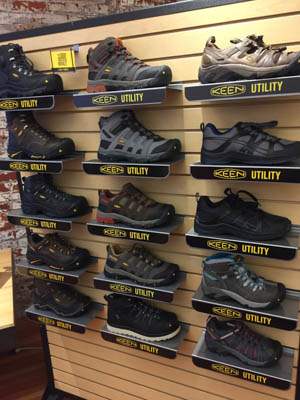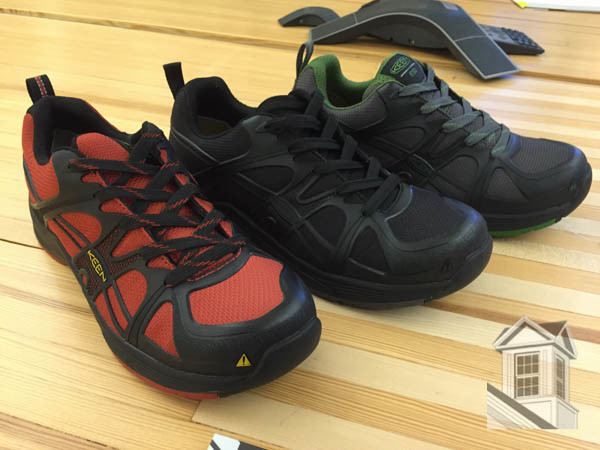Choosing a Workboot
Choosing a Workboot
 In today’s marketplace, more workboots are available than ever before. The sheer number of choices can be overwhelming. In this article we’ll give you some helpful tips and advice to help you narrow down the field when choosing a workboot.
In today’s marketplace, more workboots are available than ever before. The sheer number of choices can be overwhelming. In this article we’ll give you some helpful tips and advice to help you narrow down the field when choosing a workboot.
Recently we attended a media event with KEEN Utility and saw their entire line of service and workboot footwear. This article uses images from the event and media packet but the advice applies to other brands as well.
Tread Pattern
Like tires, the tread pattern of a work boot has a direct effect on how the boot works for a desired task. For example, you wouldn’t use a super swamper tire to go road racing. In the same light you don’t want to have an aggressive boot tread as a finish carpenter. The bigger the lug, the better the traction in loose or muddy conditions but also the more debris that’s carried into a customer’s home. If you’re an excavator, concreter, or mason an aggressive tread is perfect for your work. If you’re a finish carpenter, electrician, or factory worker, a smooth anti-slip sole is best for you. And maybe your job is a mix of rough and smooth terrain so something more middle of the road will get the job done.
Major Features
Toe Protection
Steel toes are the feature most think about when it comes to toe protection but they aren’t the only option. Toe protection comes in aluminum and composite toes too. In Canada the composites are really popular because there is a misconception that a steel toe will make a boot colder. While I’m not looking to start a debate, I can tell you that all three toe protection types meet the same ANSI standard. This standard is what gives you confidence that your toes will be ok if a reasonable size object falls on them. Some of you reading this may not need toe protection in your line of work and many boot styles also come in soft toe (absence of steel, aluminum, or composite toe protection).
Ankle Support
Many work boot styles come in multiple heights. The heights are what offer the varying levels of ankle support. The heights are usually designated low, mid/6″, or high/8″. The more uneven and rough a site may be, the more ankle support that is needed. For example, take the KEEN Utility Braddock Mid AL WP boot we reviewed over on Tool Box Buzz. It is a mid height boot offering adequate ankle protection for most job sites. I’m not worried about rolling my ankle if I step on a boulder or chunk of clay walking around in the hole on the jobsite. As we move on to interior finishes for this project though I’m going to be switching to the KEEN Durham AT ESD; a low shoe with an aluminum toe and smooth anti-slip sole to mitigate the crud carried in.
Waterproof/Breathable
In Minnesota, it has been the wettest summer I can remember. Of course it’s probably this way because the current jobsite involves a deep basement. All summer the water pump has been running almost every day so that we can keep building instead of sinking in the slimy clay. I’ve been very thankful to have a pair of the waterproof Braddocks mentioned above but not everyone needs a waterproof boot. It used to be that if you wanted a waterproof boot, you had to get used to a bit of foot sweat. That isn’t the case any more; modern fabrics allow both breathability while maintaining a breathable quality. If you need something more breathable like a tennis shoe, then something more like the KEEN Atlanta Cool may fit your work.
Après–work
The styles of today’s workboots are changing. Quickly fading are the days of taking off your boots as soon as the quitting time whistle blows. Users are gravitating away from traditionally styled boots in favor of ones that look good off the jobsite as well. Colors and styles of boots are blurring the lines between a traditional work boot and a casual shoe. I remember the first time I stepped onto a jobsite with a hiking-inspired boot. My foreman said I needed real workboots to work that day, I had to show him that they had a steel toe and other features of a heavy duty boot while still being appropriate for after work activities. KEEN is a manufacturer that has really jumped in whole hog with modern styled boots and their sales numbers show this trend is gaining momentum with contractors in the US and Canada.
Choosing a Workboot for You
I touched on some of the major features and options above but your needs may be different. Go to a manufacturers website and select your own criteria that’s important to your job to help narrow down your choices when choosing a workboot. KEEN’s can be found here, Timberland’s here, and Red Wing’s here.












